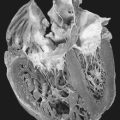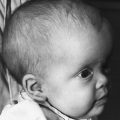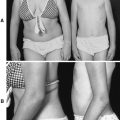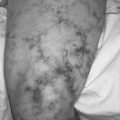68. Pemphigoid/Pemphigus
Definition
Pemphoigoid and pemphigus are a group of chronic, autoimmune blistering diseases that are classified depending on the tissue predominately involved. Cicatricial pemphigoid (CP) predominately affects the mucous membranes, such as the conjunctiva, buccal membrates, and oropharynx, whereas bullous pemphigoid (BP) predominately affects the skin.
Pemphigoid/Pemphigus Variants
Pemphigoid
• Bullous pemphigoid
• Cicatricial pemphigoid
Pemphigus
• Erythematous pemphigus
• Pemphigus foliaceous
• Pemphigus vegetans
• Pemphigus vulgaris
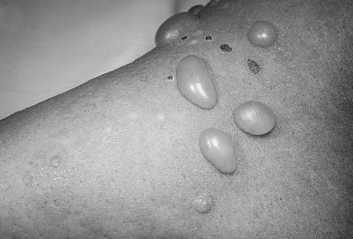 |
| Pemphigoid/Pemphigus. Bullous pemphigoid; close-up of tense bullae. |
Incidence
The exact incidence of pemphigoid/pemphigus is not known.
Etiology
In CP, basement membrane zone target antigens, bullous pemphigoid antigen Z (BPAGZ), and epiligrin are attacked by autoantibodies.
In BP, the true cause is unknown; however, several possible contributing factors have been proposed, including immunogenetics, age, epitope spreading, complement activation, and chemokines.
Signs and Symptoms
Cicatricial Pemphigoid
• Alopecia from scalp erosions
• Ankyloblepharon
• Conjunctivitis
• Corneal epithelium keratinization
• Corneal sulcus shortening
• Dysphagia
• Epistaxis
• Erosions of the genitelia (clitoris, labia, glans, penile shaft)
• Hoarseness
• Nasal crusting
• Ocular dryness
• Pruritus
• Recurrent, painful erosions of the mouth, particularly the gingivae, palate, and buccal mucosa
• Severe ocular inflammation (unilateral or bilateral) after eye surgery
• Symblepharon
• Synechiae
Bullous Pemphigoid
• Dysphagia
• Exfoliative erythroderma
• Generalized atopic dermatitis
• Generalized bullous formation on palms and/or soles
• Psoriasis-like skin appearance
• Tense bullae (particularly on flexible skin surfaces)
• Urticarial or erythematous-based small, tense blisters (vesicular form)
• Vegetating plaques in intertriginous skin areas (vegetative form)
Medical Management
Therapeutic measures for either CP or BP are directed toward decreasing formation of blisters, promoting healing of blisters and/or erosions, and determining the minimal effective dose to control the disease processes. Therapeutic measures must be individualized and take into account any preexisting condition(s) the patient may have.
Bullae and/or erosions should be gently cleaned on a daily basis. Compresses, topical agents that promote wound healing, and/or biologic dressings may be applied to minimize trauma, hasten healing, and reduce scarring.
The patient with CP may need ongoing ophthalmic evaluation because of the high degree of involvement of the eyes. Ablation of ingrown eyelashes may be necessary to prevent further damage to the eyes. The mucosal membranes of the pharynx and/or trachea may produce significant respiratory compromise and require tracheostomy. Scarring of the esophagus may necessitate repeated dilation procedures.
Complications
• Adrenal suppression
• Ankyloblepharon
• Blindness
• Bone marrow suppression
• Corneal keratinization
• Esophageal strictures/stenosis
• Fornices foreshortening
• Fractures
• Growth retardation
• Infection (localized or systemic)
• Malignancy
• Osteoporosis
• Symblepharon
• Synechiae
• Tracheal stenosis
• Trichiasis
• Visual acuity loss
Anesthesia Implications
Airway management is always a strong concern for the anesthetist and is magnified for patients with CP. Blister formation occurs easily in the patient with CP, even with relatively insignificant trauma, such as while eating food that is hard (e.g., chips, raw vegetables). As a result, airway compromise may be present when the patient presents to the operating room. Direct laryngoscopy and other instrumentation should be avoided if possible, but when unavoidable, should be undertaken with great caution. The anesthetist should expect to produce blisters during direct laryngoscopy. In addition, the airway should be secured with a smaller than usual endotracheal tube to reduce the degree of trauma to the vocal cords and trachea. Because of the friction involved in the placement procedure, the laryngeal mask airway should be avoided in the patient with pemphigoid/pemphigus.
As an autoimmune disease, treatment may consist of immunsuppression agents. Bone marrow toxicity and extensive hepatic effects may be present in the patient with pemphigoid. Bone marrow toxicity may significantly alter the patient’s hematopoiesis perioperatively. Liver function and complete blood count levels should be evaluated preoperatively. The anesthetist should be aware that the patient with pemphigoid may be chronically dehydrated due to lack of oral intake as the result of pain from oral or oropharyngeal blisters and/or erosions. Therefore hemoglobin and hematocrit values may be artificially “normal” or even appear to be elevated. In addition, the self-restriction of nutrition and fluids as the result of the pain may also result in significant alterations in the electrolyte concentrations. Significant electrolyte losses may result from rupture and drainage of the numerous blisters the patient may have.
A patient with either form of pemphigoid is likely to be receiving corticosteroid medications as a part of the immunosuppression therapy. The patient should receive a perioperative dose of corticosteroid; an exacerbation of the disease is possible should the corticosteroid coverage be omitted.

